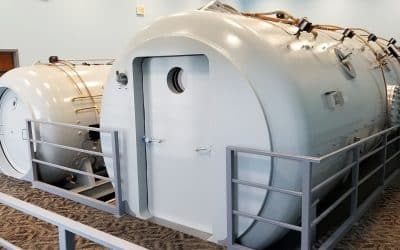Abstract: Neuropathic pain after nerve injury is severe and intractable, and current drug and non-drug therapies offer very limited pain relief. Hyperbaric oxygen (HBO 2) has been clinically used for protection of the nervous system after acute injury. We investigated...
Peripheral Neuropathy
Hyperbaric Oxygen Therapy (HBOT) Research for Peripheral Neuropathy
Fabry disease presenting with sudden hearing loss and otosclerosis: a case report.
Abstract: Fabry disease is an X-linked lysosomal storage disorder resulting in a multiple-system disorder with a wide spectrum of physical signs and symptoms, predominantly affecting the central and peripheral nervous systems, skin, heart, kidneys, and eyes. We...
Effect of hyperbaric oxygen therapy on tense repair of the peripheral nerves.
Abstract: After a peripheral nerve cut, tense repair of a nerve compromises circulation of the nerve at the injury site, making the site hypoxic. Hyperbaric oxygen might increase tissue oxygenation and therefore diminish the effects of injury. We investigated whether...
Hyperbaric oxygen therapy and promoting neurological recovery following nerve trauma.
Abstract: There is a constant search for new techniques that induce more extensive and rapid wound healing. Hyperbaric oxygen therapy (HBO2T) involves placing a patient in a sealed chamber and elevating its pressure several-fold above ambient air pressure while the...
Painful diabetic neuropathy: an update.
Abstract: Diabetes, a silent killer, is a leading cause of neuropathy. Around 50% of diabetic patients develop peripheral neuropathy in 25 years. Painful diabetic neuropathy manifests as burning, excruciating, stabbing or intractable type of pain or presents with...
Hyperbaric oxygenation therapy alleviates chronic constrictive injury-induced neuropathic pain and reduces tumor necrosis factor-alpha production.
Abstract: The development of hyperalgesia and allodynia after chronic constrictive injury (CCI) is associated with significantly increased tumor necrosis factor (TNF)-α and interleukin (IL)-1β. Theoretically, if the production of TNF-α and/or IL-1β could be reduced,...
Prevalence of neuropathy in the diabetic foot.
Abstract: To illustrate the prevalence of different types of neuropathy in diabetic patients with diabetic foot. This is a retrospective study of 229 diabetic foot patients treated at Princess Haya Hospital Hyperbaric Department, Aqaba, Jordan from January 1997 to...
Cauda equina syndrome following combined spinal and epidural anesthesia: a case report.
Abstract: To describe a case of complete neurological recovery from cauda equina syndrome lasting ten months following spinal anesthesia with 0.5% hyperbaric bupivacaine and epidural anesthesia with ropivacaine, and to discuss the possible mechanisms involved. A...
Gadolinium enhancement of cauda equina after combined spinal-epidural anaesthesia.
Abstract: The occurrence of neurological symptoms after spinal anaesthesia has been reported with several local anaesthetics including lidocaine, prilocaine, mepivacaine, tetracaine and bupivacaine. Although hyperbaric bupivacaine is known to induce neurological...


